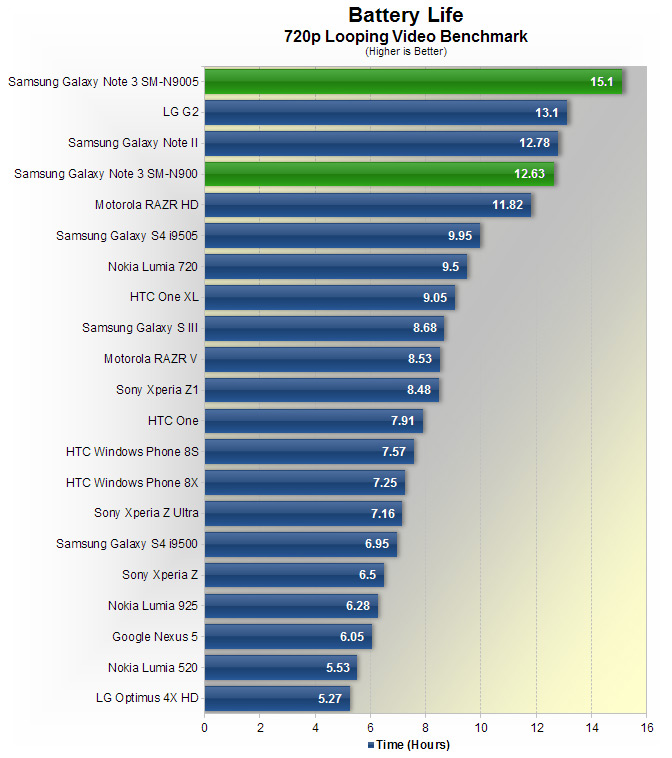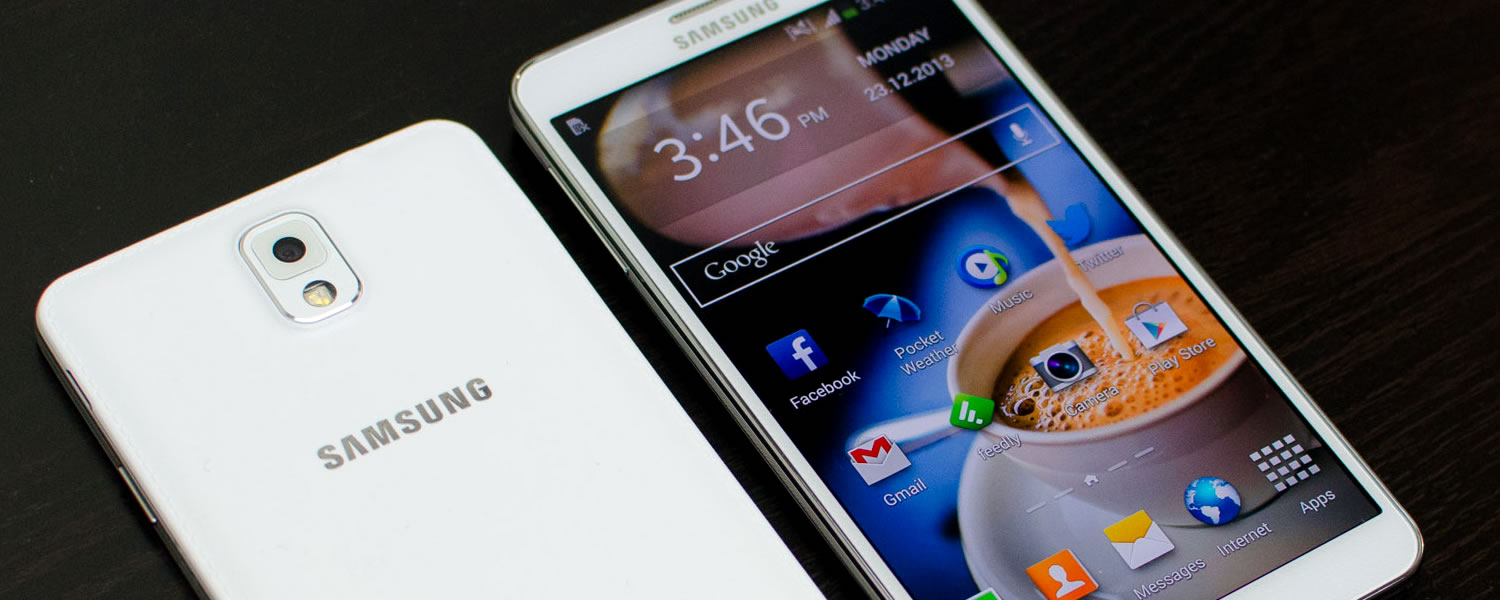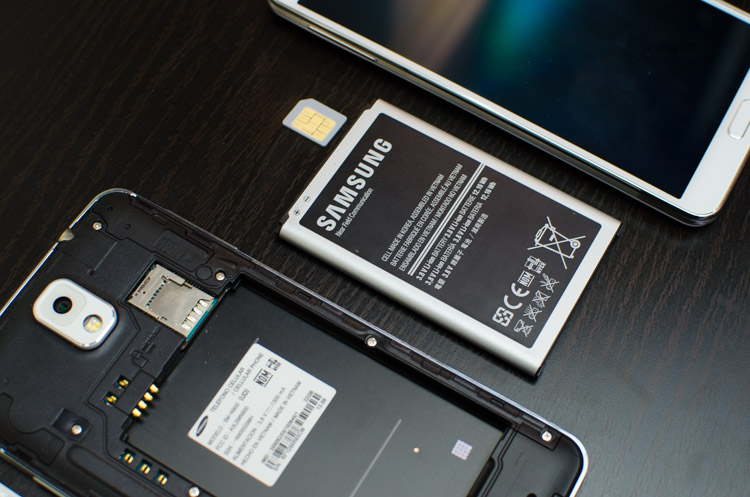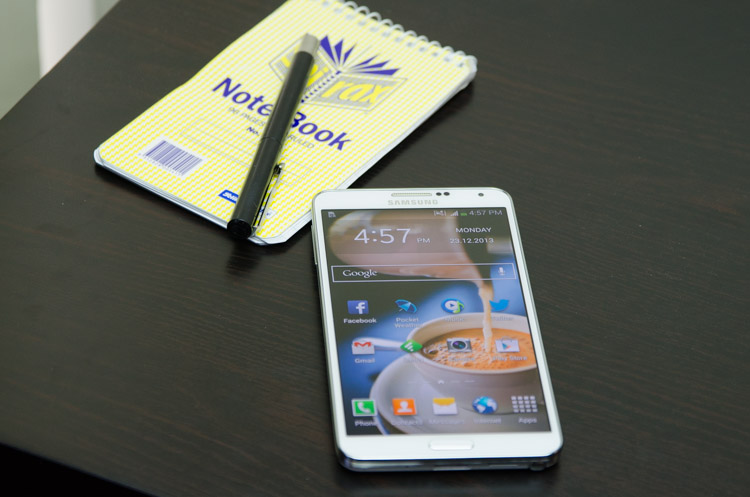Battery Life, Wrap Up
Until the LG G2 came around a few months ago, the Samsung Galaxy Note II had held the crown in our battery life rundown test. I'm expecting an equally solid battery showing from the Galaxy Note 3, which sees a slightly increased battery size, jumping from 11.78 Wh to 12.16 Wh (3,200 mAh at 3.8 V). Both the Exynos 5420 and Snapdragon 800 SoCs are more power efficient than the Exynos 4412 used in the Galaxy Note II, which should also bring stamina improvements.
During my time using both the Exynos and Snapdragon Galaxy Note 3 variants, the battery life I experienced was very good. Despite the sizable 5.7-inch AMOLED display, in general usage I was usually left with around half the juice remaining in the battery after a day's usage. Especially on Wi-Fi, both models appear to be very power efficient; I could reasonably expect to browse web pages for 10 hours on Wi-Fi, which would be a fantastic result.
When the powerful quad-core CPU and top-end GPU has to fire up, such as in 3D-intensive games, the expected battery life noticeably decreases as it would in any other portable device. If you plan on using the Note 3 as a handheld gaming console for titles such as GTA: San Andreas, you could probably get around six hours of solid usage at best, going on my usage patterns in the spells of gaming I did on the device.

Looking at our battery life rundown test, the Galaxy Note 3 SM-N9005 (Snapdragon 800 model) tops the charts by delivering just over 15 hours of playback, dethroning the LG G2. Meanwhile, the Exynos Note 3 still performs admirably, lasting essentially just as long as the Galaxy Note II.
The Snapdragon model delivered 20% better battery life than the Exynos model, which may seem like a lot, but recall that the Galaxy S4 Snapdragon model was a full 43% ahead when I tested it earlier this year, showing that Samsung is closing the gap. Large-screen competitors such as the Sony Xperia Z Ultra didn't really stand a chance up against the Note; the SM-N9005 lasted more than twice as long as Sony's offering.
Final Thoughts
After several weeks with a Galaxy Note 3 in hand, it's clear that it is the best large-screened, stylus-supporting smartphone you can get. The S-Pen is the perfect companion tool for annotations on the fly, with some seriously impressive software enhancements - especially S Note and Action Memo.
Performance from the Galaxy Note 3 is fantastic, and this time both the Exynos and Snapdragon models are up to scratch. There's still no HMP support for the octa-core Exynos, but the lag is gone and performance is largely on-par with the Qualcomm model. I'd still be wanting Snapdragon-only features such as LTE and 4K video recording in my Note, but the Exynos model is still a solid choice.
The 13-megapixel camera performs well in most lighting conditions. Battery life is also very good, keeping up the Note tradition of easily lasting all day with a lot of juice to spare, despite the large display. The 5.7-inch 1080p AMOLED panel is impressive and quite pretty to look at, if a tad inaccurate and not as high-quality as a competing LCD display.
No Samsung phone is complete without some ackward design choices though. Going with fake, plastic leather on the back panel is simply terrible, diluting other improvements made to the design on this iteration. The software, while good in some areas, is still laden with a heavy, ugly skin and tons of useless bloatware and gimmicks.
The Galaxy Note 3 isn't the greatest smartphone money can buy, but it's the best option in the category it fills, sure to keep Samsung dominant for another year or two.
score
Pros: The included S-Pen is fantastic, further enhanced by strong software support. Top-notch performance from both models, plus a decent camera and great battery life. Reasonably ergonomic, despite its size.
Cons: Faux-leather design makes the device look like a cheap knock-off. Software is bloated, visually unpleasant and filled with gimmicks. As LCDs advance, AMOLEDs are being left behind.


